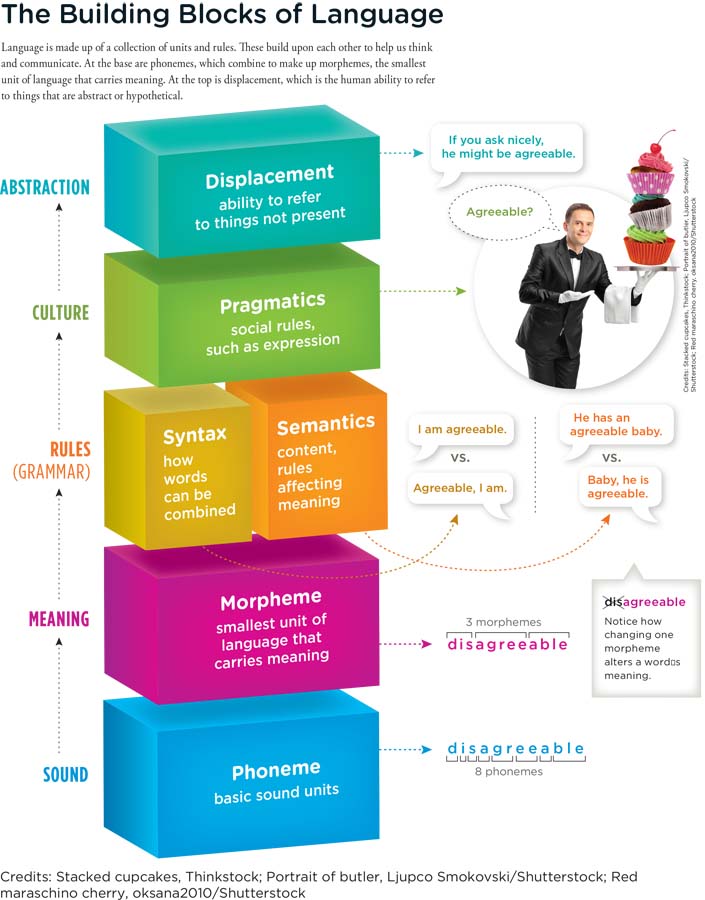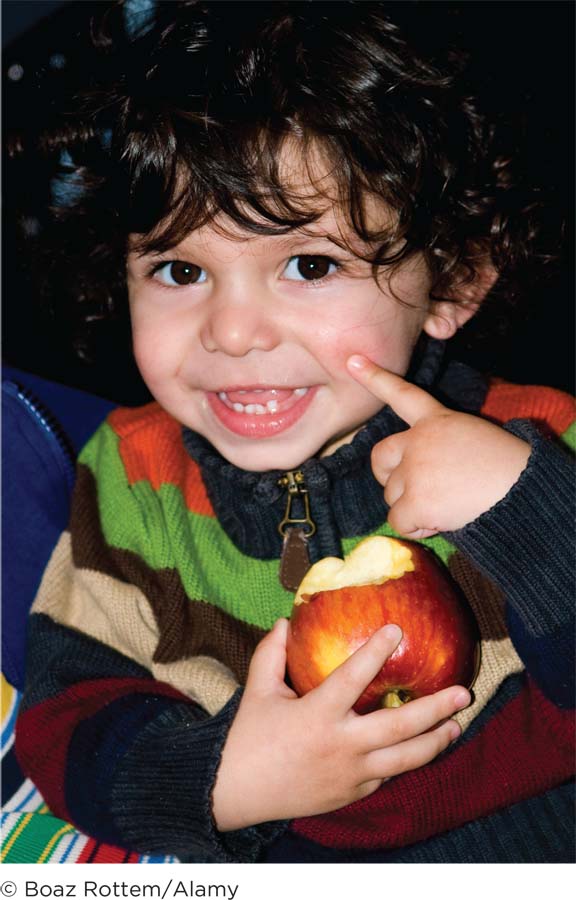7.3 Language
279

A close-
 ELVES, PIRATES, AND READING TROUBLES Right around the time that Dr. Jill Bolte Taylor’s life was uprooted by a massive brain hemorrhage, an aspiring actor by the name of Orlando Bloom was launching his career on the big screen. In 1997 the 19-
ELVES, PIRATES, AND READING TROUBLES Right around the time that Dr. Jill Bolte Taylor’s life was uprooted by a massive brain hemorrhage, an aspiring actor by the name of Orlando Bloom was launching his career on the big screen. In 1997 the 19-
Starring in adventure films requires extensive training in sword fighting, archery, and martial arts, but according to those who have seen Orlando in action, the athletic demands of the job are not an issue. “Orlando is all physical grace,” says fellow actor Liam Neeson (Sella, 2005, para. 39). Acting also presents a major cognitive challenge, as it requires reading and memorizing thousands of lines. This part of the job may not come so easily for Orlando, however, because he has dyslexia.
Dyslexia, or specific reading disability, is characterized by difficulty reading, writing, spelling, and/or pronouncing (International Dyslexia Association, 2015). Although people with dyslexia struggle with reading, all the presumed prerequisites for good reading (adequate intelligence and eyesight, desire to learn, access to good instruction, for example) appear to be in place. Yet, the person still has trouble mastering fundamental skills (Shaywitz, 1996; Shaywitz & Shaywitz, 2005).
Synonyms
dyslexia developmental reading disorder
School was an endless struggle for Orlando. “Homework was always hard for me. Writing essays . . . getting my thoughts on the page, it was so difficult,” he acknowledged in a 2010 interview with the Child Mind Institute (Freedom of Speech Ltd, 2014, March 10). Whenever it was time to read aloud in class, young Orlando would say that his throat was hurting, or that he felt ill—
The impact of dyslexia can be far-
When dyslexia was first recognized over a century ago, many people assumed children fell behind in reading because they were ignorant or lazy, or had bad teachers (Shaywitz, 2003; Wolf, 2007; Zimmerman, 2014, June 19). Scientists have since discovered that dyslexia is rooted in the brain. With scanning technologies such as fMRI, scientists can examine the brain of someone with dyslexia as she reads, writes, or speaks. “We now know exactly where and how dyslexia manifests itself in the brain,” writes dyslexia researcher Sally Shaywitz (2003, p. 4). Dyslexia, the evidence suggests, is caused by defects in the brain’s ability to retrieve and manipulate certain components of language (Démonet, Taylor, & Chaix, 2004).
The Power of Language
280
Language is an amazing ability. Try to imagine human relationships in its absence. There would be no saying “What’s wrong?” or “I love you.” Language gives us the power to explicitly convey complex thoughts and feelings to others, and that is a remarkable feat.
LO 8 Define language and give examples of its basic elements.
language A system for using symbols to think and communicate.

Language can be defined as a system for using symbols to think and communicate. These symbols are words, gestures, or sounds put together according to specific rules. While a small number of words are onomatopoetic—
Construct as many sentences as you can that include the following words: “giraffe,” “kitten,” “blue,” “pretty,” “rough,” “run.”
try this
The average English speaker is familiar with some 30,000 (Lessmoellmann, 2006, October 4) to 60,000 words (Pinker, 1994). What’s more, humans are always finding new meanings for old words or inventing new ones. If we say “apple product,” for example, we could be referring to a crunchy red fruit or to a fancy new computer. Just think of how many new words have come from the use of digital technologies like text messaging and social media. Do you know what “friend farming” is? (We didn’t, btw.) It is the “practice of adding many contacts (on Facebook or other social media) by using a list of another person’s friends” (Merriam-
The Basic Elements of Language
Language can be written, spoken, and signed. Speaking comes naturally to us because we are born with brains evolved for that purpose (Shaywitz, 1996). Young Orlando did not need speaking and listening lessons; neither did you. Children learn to speak by hearing others talk. (In Chapter 8, we will describe the consistent pathways through which language develops for children.)
Dyslexia usually begins to manifest itself as soon as a child starts learning to read, often in kindergarten. Think back to your first reading lesson. Your teacher probably introduced you to written language by teaching you to break words into their basic sound units (for example, the combination of kuh, aah, and tuh to form the word “cat”; Shaywitz, 1996). She was introducing you to phonemes.
phonemes (fō-nēmz) The basic building blocks of spoken language.
PHONEMES Phonemes (fō-nēmz) are units of sound that serve as the basic building blocks of all spoken languages. The symbols we call words are made up of phonemes. Examples of English phonemes include the sounds made by the letter t in the word “tail” and the letter s in the word “sail.” Every phoneme has its own individual characteristic(s) (Infographic 7.3). For example, the letter i can represent two clearly different phonemes, as in the words “bit” and “bite.”
281
INFOGRAPHIC 7.3

282
Infants can recognize all phonemes from all languages until about 9 months of age. After that, they can no longer distinguish between phonemes that are not in the language(s) they regularly hear spoken (de Boysson-
If you have children (or plan to have them), it wouldn’t hurt for them to learn more than one language very early in life. Not only will their pronunciation sound natural; they may enjoy some cognitive perks, too.
didn’t SEE that coming
The Perks of Being Bilingual
 Psychologists once thought that the brain was best suited for learning a single language, and that exposing children to more than one language frustrated their intellectual development (Klass, 2011, October 10). Researchers are now uncovering evidence that learning two languages does not lead to word mix-
Psychologists once thought that the brain was best suited for learning a single language, and that exposing children to more than one language frustrated their intellectual development (Klass, 2011, October 10). Researchers are now uncovering evidence that learning two languages does not lead to word mix-

A sign conveys a message in English and Spanish, suggesting that both languages are spoken in this area. Speaking two languages may boost the brain’s ability to manage many different activities (Bialystok, 2011).
DOES BEING BILINGUAL CLUTTER YOUR BRAIN?
Bilingualism has been associated with enhanced creativity, abstract thought, and working memory. Among the most striking qualities associated with bilingualism are strong executive control and more efficient executive functioning (Bialystok, 2011; Engel de Abreu, Cruz-
A study of 7-
Why is this so? The bilingual brain is constantly exercising its executive control system. A person who speaks two languages cannot just turn on one language and turn off the other; the knowledge of both is always present and awake. The speaker is eternally torn between the two competing languages. Resolving this ongoing conflict seems to keep the executive control system very busy and always practicing (Bialystok, 2011). 
HOW WE READ Understanding phonemes is the first and most essential step in reading. In order to digest writing on a page, your brain must chop words into these fundamental sound bites (Shaywitz, 1996, 2003). This is where young Orlando probably encountered his first and most disabling roadblocks. A growing body of evidence suggests that the roots of dyslexia frequently lie in a person’s problems with phonological processing (Shaywitz, Mody, & Shaywitz, 2006), the ability to distinguish and manipulate phonemes. Like most children with dyslexia, Orlando probably had trouble naming letters in the alphabet and knowing what sounds they make, identifying words that rhyme (for example, “hat,” “mat,” “rat”), and understanding how a word changes when one letter is swapped for another (for example, the transformation of “cat” to “cut” when the middle vowel is changed; L. Hecker, personal communication, July 22, 2011). If a child with dyslexia does not receive the special instruction he needs to overcome difficulties with phonemes, mastering the more complex layers of written language will be very challenging.
morphemes (mȯr-
283
MORPHEMES Morphemes (mȯr-
syntax The collection of rules concerning where to place words or phrases.

SYNTAX The syntax of a language is the collection of rules dictating where words and phrases should be placed. Syntax guides both word choice and word order, providing consistency in sentence organization (Brandone, Salkind, Golinkoff, & Hirsh-
grammar The rules associated with word and sentence structure.
semantics The rules used to bring meaning to words and sentences.
GRAMMAR AND SEMANTICS Grammar refers to the rules associated with both word and sentence structure (Evans & Green, 2006). It tells us how words are made from sounds, how sentences are formed with words, where to place punctuation, and which word tenses to use. It combines syntax (the rules governing word choice and word order) and semantics. Semantics represents the rules used to bring meaning to words and sentences. Here are two sentences with different syntax, but the same semantics: Jill kicked the ball. The ball was kicked by Jill.
Semantics also refers to the context in which words appear. Let’s consider the word “chip”:
I would like to eat a chip.
You have a chip on your shoulder.
I lost my last chip in that hand.
You need to make a chip shot.
The new policy will finally start to chip away at the retirement benefits.
The store just installed a new computer chip.
In each instance, we determine the meaning of the word “chip” based on the context in which it is used in the sentence.
pragmatics The social rules that help to organize language.
PRAGMATICS Language is used in social interactions, which are governed by certain norms and expectations. Pragmatics are the social rules that help organize language. We have to learn how to take turns in a conversation, what gestures to use and when, and how to address people according to social standing (speaking with someone who occupies a higher status, an equal status, and so on) (Steiner, 2012, September 4; Yule, 1996). When addressing the Queen of Denmark, you would say, “Good day, Your Majesty,” but when addressing your friend, you might say, “Hey, there.”
How do we “know” these rules for language? Learning theorists propose that children learn language just like they learn other behaviors, through processes such as reinforcement and modeling (Bandura, 1977a; Skinner, 1957). In contrast, linguist Noam Chomsky (1928–
284
THINK again

Deaf babies who are exposed to sign language develop their own version of babbling. Instead of rattling off spoken syllables (da-
Language Without Sound
 If Chomsky is right, then children would learn all languages, including signed languages, in basically the same way. Evidence suggests this is exactly what happens.
If Chomsky is right, then children would learn all languages, including signed languages, in basically the same way. Evidence suggests this is exactly what happens.
DEAF BABIES BABBLE WITH THEIR HANDS
No one sat down with you and “taught” you language. You just picked it up because people around you were using it. The same is true for all native speakers, whether they converse in Russian, Mandarin, or American Sign Language (ASL). ASL is a language with symbols, syntax, and a grammatical structure that parallels spoken language (Petitto, 1994). When people speak sign, some of the same regions of the brain are activated as when spoken language is used (Horwitz et al., 2003; Levänen, Uutela, Salenius, & Hari, 2001).
Spoken and signed languages also share the same critical period for acquisition. Between birth and 5 years old, the brain is highly plastic and ready to incorporate any language, but after that critical period, fluency is difficult to develop (Humphries et al., 2012).
Even the stages of language acquisition appear to proceed along the same path. Research suggests, for example, that deaf babies pass through a babbling stage around the same time as hearing babies. If you are unfamiliar with babbling, we are referring to the ba-
DISPLACEMENT Many scientists argue that language, more than any other human ability, truly sets us apart from other species. Animals have evolved complex systems of communication, but some features of human language appear to be unique. One of these unique features is displacement—
Thinking What We Say or Saying What We Think?
LO 9 Explain the linguistic relativity hypothesis and its relation to language and thought.
Psychologists are not in total agreement about the relationship between language and thought. The major controversy concerns the potential effect language can have on thinking. According to the linguistic relativity hypothesis (earlier known as the Sapir–
285
Whorf’s hypothesis is not universally accepted, however. Critics suggest that he exaggerated the number of words the Inuit and other Alaska Natives had for “snow” and underestimated the number of words in English (Pullum, 1991). For example, although English doesn’t have different words for “snow,” this does not mean that we don’t understand or cannot express understanding using word combinations (such as “light snow,” “wet snow,” and the like).
Whorf also observed different color-
Although language might not determine thinking and perception, it certainly has an influence. Consider the role of gender in language. The English language tends to use “he” and “his” when gender is unspecified. Research indicates that the use of masculine pronouns often results in people ignoring females and focusing on males when forming mental images (Gastil, 1990; Hegarty & Buechel, 2006). “He” and “his” in these situations theoretically refer to either males or females, but the majority of English-
The capacity for language is one of the defining characteristics of humanity. But it is not certain whether this capacity is unique to human beings. Animals communicate with a variety of instinctual (unlearned) behaviors (for example, chirping, whistling, tail slapping, and dancing). Is it possible they use language as well? Read on and draw your own conclusions.
286
CONTROVERSIES
Do Animals Use Language Too?
 Rico was a border collie in Germany who knew 200 vocabulary words, including the name of a bunny toy, “Kaninchen,” and a little Santa Claus named “Weihnachtsmann” (Newsweek, 2004, June 20). When Rico’s owners instructed him to fetch a certain toy, he would run into the next room and race back with that exact toy in his mouth. So impressive was the dog’s verbal comprehension that a team of researchers decided to make him the focus of a case study. They concluded that Rico was capable of “fast-
Rico was a border collie in Germany who knew 200 vocabulary words, including the name of a bunny toy, “Kaninchen,” and a little Santa Claus named “Weihnachtsmann” (Newsweek, 2004, June 20). When Rico’s owners instructed him to fetch a certain toy, he would run into the next room and race back with that exact toy in his mouth. So impressive was the dog’s verbal comprehension that a team of researchers decided to make him the focus of a case study. They concluded that Rico was capable of “fast-

Rico the border collie demonstrated his linguistic prowess by learning to recognize 200 words. More recently, researchers trained another border collie by the name of Chaser to recognize the names of 1,022 objects (Pilley & Reid, 2011).
HOT DOG!
Rico is not alone in possessing exceptional communication skills. The green-
There is no question that animals are capable of sophisticated communication. But does that communication qualify as language? Keep in mind that animals need extensive training to learn and use vocabulary (you don’t think Rico learned 200 words on his own, do you?), while human children pick up language through exposure. To our knowledge, only people have the ability to convey a vast number of ideas through complex grammatical constructs, and apply those constructs to critical thinking. Even if animals do possess rudimentary language abilities, humans appear to be the only species capable of grasping and using intricate sentence structures (Lessmoellmann, 2006, October 4; Pinker, 2003). 
show what you know
Question 1
1. _________ are the basic building blocks of spoken language.
Phonemes
Question 2
2. According to the linguistic relativity hypothesis, language differences lead to differences in:
phonemes.
thinking and perception.
the language acquisition device.
displacement.
b. thinking and perception.
Question 3
3. The Dutch word gezelligheid does not really have a one-
Answers will vary. Bilingualism is associated with enhanced creativity, abstract thought, and working memory. And knowing more than one language has been found to be associated with more efficient executive functioning, including abilities related to planning ahead and solving problems. Thus, bilingualism may actually improve performance on cognitive tasks, such as deciphering unknown and untranslatable words.